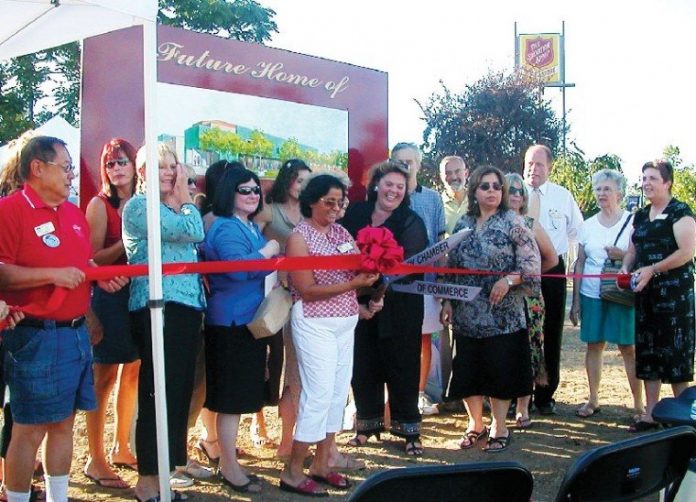Local artists and city officials gathered at a downtown dirt lot
to cut a ribbon for an arts center they don’t have yet, and won’t
have until the city reevaluates the project’s cost at a time when
it might also need money to buy Gilroy Gardens.
Gilroy – Local artists and city officials gathered at a downtown dirt lot to cut a ribbon for an arts center they don’t have yet, and won’t have until the city reevaluates the project’s cost at a time when it might also need money to buy Gilroy Gardens.
The $10 million earmarked for the arts center is not nearly enough, and the building’s likely to cost about $25 million, according to Community Services Director Susan Andrade-Wax. On top of this, the Gilroy Arts Alliance – a year-old group of about 50 local artists and art-lovers who have spent the last year raising money to run their planned center – lacks a business plan to assure the City Council that the art haven won’t need city funds to operate after its open. Andrade-Wax estimated it will take about six months to produce the plan that will also revise building costs ahead of the planned 2009 groundbreaking.
None of this stopped the GAA from formally joining forces with the Chamber of Commerce at Thursday evening’s ribbon-cutting ceremony.
“Normally a ribbon-cutting takes place on a doorstep, but lo and behold, our organization has no doorstep at this time,” said Carol Harris, GAA president. “We simply have a dirt lot and the hope and passion that one day we’ll see the Gilroy Center of the Arts materialize on this site” at the northwest corner of Seventh and Monterey Streets.
All this camaraderie comes amid the city’s potential acquisition of Gilroy Gardens’ 536 acres along scenic Hecker Pass Highway, which could cost between $13 million and $25 million.
To finance the purchase, Assistant City Administrator Anna Jatczak said she imagined borrowing $4.5 million from the general fund and getting $7.9 million from possibly three other sources. One could be borrowing money from a private lender, another could be “borrowing against ourselves” with an “inter-fund loan” from uncommitted money that would otherwise finance storm drains, sewer projects, city fleets, equipment and information technology. The final potential source could be money slated for the postponed arts center.
“We have money in the bank for the arts center, and we know we don’t have enough,” said Andrade-Wax, adding that the city could put this money toward Gilroy Gardens and then bond the arts center. “Gilroy Gardens won’t pre-empt the arts center. It’s a matter of bonding for the arts center versus bonding for the gardens.”
Councilman Dion Bracco agreed that any Gilroy Gardens purchase won’t derail the arts center, but he cautioned that the center “has to fly on its own.”
“The art center is on hold and has nothing to do with the park,” Bracco said, “So far there doesn’t seem to be a whole lot of interest in an arts center. We have a couple nonprofits that want to use it, but that’s it … You can go to Morgan Hill and see its art center is empty all the time. That’s what we’re trying to avoid,” Bracco said.
The roughly 30 people from the GAA, various nonprofits, and the city’s Arts and Cultural Commission at the site Thursday disagreed with Bracco’s characterization, though.
“We’re very excited about our prospects, and we’d like the City Council to fast-track the center, but I know it’ll be a while because of Gilroy Gardens,” said Bruce Morasca, president of the Theater Angels Arts League, which is one of the GAA’s 14 community partners, along with the South Valley Symphony and the Gilroy Foundation, which kick-started the entire effort two years ago thanks to Donna Pray, executive director of the foundation.
The foundation, which has $6 million in assets, gave the Arts and Cultural Commission $50,000, Pray said. The Commission has used that money to promote local art and artists and to establish the alliance, which, in turn, has spent $28,000 of the $50,000 over the last year on mailings and to host a series of “stakeholder dinners” that drew about $1.5 million in donations, $1.25 million of which came from Don Christopher, according to Pray. The GAA hopes for $3 million so it can finance the center’s operations with interest and not have to solicit the city for money.
“As artists, we’re used to digging out from six feet under,” said Sandra Marlowe, one of 10 GAA board members. Marlowe cited a Georgia Tech study on nonprofit art centers proving that they spur economic activity. “Arts and business can go hand in hand,” Marlowe said, adding that the planned arts center will be a economic, social and political force within the community. Harris also pointed to San Jose’s downtown turnaround as “largely due to the arts.”
Local artist Nader Khaghani brimmed with optimism after the women’s speeches.
“I am extremely excited. It’s about time for Gilroy to be known for the quality of art we have,” said Khaghani, a painter for the past 30 years who displayed his work alongside fellow local artists Bernadette Engehausen and Shirley Dwyer. “When artists come in, a place turns cool, business picks up, and prices of houses go up,” Khaghani said.
While the new center will have a theater, Arts and Cultural Commissioner Dia Hoshida floated the idea of merging the arts center with Gilroy Gardens since it has an amphitheater and gazebos. “We want it all,” Dia said.
The artists want something, at least.
“I don’t think the arts are as appreciated as they need to be,” Dwyer said as she stood next to her landscape portraits. “We just have our little group right now, and we’re very excited about something happening here.” Engehausen agreed and said she looked forward to the center “making up for the lack of art programs in schools.”
It’s all a matter of time, said Councilmen Russ Valiquette and Peter Arellano.
“Eventually there will be an arts center there,” Valiquette said, “but when and how much it’s going to cost, nobody knows.”














